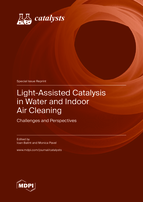Light-Assisted Catalysis in Water and Indoor Air Cleaning: Challenges and Perspectives
A special issue of Catalysts (ISSN 2073-4344). This special issue belongs to the section "Photocatalysis".
Deadline for manuscript submissions: closed (30 September 2022) | Viewed by 34763
Special Issue Editors
Interests: surface science: non-isothermal gas desorption kinetic from supported-metal catalysts; solid defect chemistry; water–gas shift reaction on surface of simple and doped ionic oxides; material synthesis: mesoporous nano oxides; mono/bimetallic metal nanoparticles; catalysis: catalytic combustion of hydrocarbons; oxidative coupling of methane; hydrogenation and oxidative conversion of conversion hydrocarbons; denox reaction; structure-sensitive reactions; nitrate and nitrite abatement; photocatalysis/light harvesting: water and air depollution; water splitting; light-induced reactive oxygen species generation; solar cell
Special Issues, Collections and Topics in MDPI journals
Interests: synthesis of catalysts by various techniques; photocatalysis; total oxidation of VOCs and light alkanes
Special Issues, Collections and Topics in MDPI journals
Special Issue Information
Dear Colleagues,
The use of light as a free energy source to mineralize the recalcitrant contaminants contained in indoor air and various water sources into harmless CO2 and H2O is currently an important issue. The large-scale application of photocatalysis in depollution is impeded by the long-term stability of photocatalytic materials, formation of harmful intermediate products, low quantum efficiency, and low reaction rates. In many cases, published works have assessed photocatalyst activity from pollutant-degraded fraction data, whereas its identification and quantification in intermediates as well as CO2 remains in the shadow. The degradation mechanism related to materials and organic substrates has been speculated upon in many cases, though without presentation of any solid experimental evidence. The relationship between ROS (reactive oxygen species, •OH, and O2−) formed by photocatalysts under light exposure and degradation mechanism also need substantial clarification. The precise quantification of in situ ROS through dedicated experiments should be an important direction of investigations. This Special Issue will present a collection of original research papers and reviews focusing on photocatalysis as applied to indoor air and water treatment with emphasis on (i) newly developed photocatalytic materials for environmental applications, (ii) identification and quantification of degradation intermediates as well as of CO2, (iii) identification and quantification of ROS through dedicated experiments, (iv) material- and light energy-related ROS generation, (v) identification of the precise role of ROS in reaction pollutant degradation mechanism and impact on selectivity, (vi) ROS-intermediated photocharge transfer mechanism from photocatalyst to organic substrate, and (vii) specific features of pollutant degradation mechanisms in aqueous and air media.
Dr. Ioan Balint
Dr. Monica Pavel
Guest Editors
Manuscript Submission Information
Manuscripts should be submitted online at www.mdpi.com by registering and logging in to this website. Once you are registered, click here to go to the submission form. Manuscripts can be submitted until the deadline. All submissions that pass pre-check are peer-reviewed. Accepted papers will be published continuously in the journal (as soon as accepted) and will be listed together on the special issue website. Research articles, review articles as well as short communications are invited. For planned papers, a title and short abstract (about 100 words) can be sent to the Editorial Office for announcement on this website.
Submitted manuscripts should not have been published previously, nor be under consideration for publication elsewhere (except conference proceedings papers). All manuscripts are thoroughly refereed through a single-blind peer-review process. A guide for authors and other relevant information for submission of manuscripts is available on the Instructions for Authors page. Catalysts is an international peer-reviewed open access monthly journal published by MDPI.
Please visit the Instructions for Authors page before submitting a manuscript. The Article Processing Charge (APC) for publication in this open access journal is 2700 CHF (Swiss Francs). Submitted papers should be well formatted and use good English. Authors may use MDPI's English editing service prior to publication or during author revisions.
Keywords
- indoor air treatment
- water cleaning
- photocatalysis
- photocatalytic materials
- semiconductors
- surface reaction
- reactive oxygen species
- recalcitrant compounds mineralization







